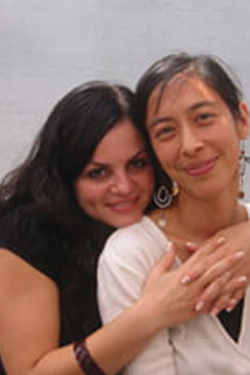
My first assignment at Oak Crest was to paint the lab. You know that red wall? Yup, I painted that with my research partner, Aleksandra Kainovic. When we started at Oak Crest in late 2003, guided there by Dr. Wendie Johnston (Pasadena Bioscience Collaborative), the facilities had just expanded into a larger space and we needed to prepare and organize our research environment. Once ready, we transitioned from paint chemistry into the chemistry of organic sulfoxides.
Marc Baum handed us a tall stack of dense journal articles, a few cups of coffee, and some ideas about the synthesis of chiral sulfoxides. Aleksandra and I were both interested in chemical processes inherent to bacterial metabolism that might be of environmental interest. Together, we fashioned an exciting project – to isolate bacteria from an extreme habitat that could oxidize sulfur compounds, biotransforming sulfides into sulfoxides. Being an unusual biochemical process, we sought an unusual environment to harvest bacterial candidates: a natural oil seep on Sulphur Mountain, known for its sulfurous waterways. Not only was this place stinky, but also sticky with black tar.
The enrichment process, to favor only those bacteria that could tolerate and possibly metabolize a growth medium spiked with simple organic sulfur compounds, produced two initial bacterial isolates with which to work. From there, our project took an interesting detour. Dr. Paul Webster of The House Ear Institute, on an Oak Crest visit, noticed our bacterial babies produced a healthy, thick biofilm. A new project was born, and we began to observe the biofilms via transmission electron microscopy, scanning electron microscopy, and confocal microscopy.
After I left Oak Crest and relocated to Northern California in 2005, the skills and confidence I developed at Oak Crest became crucial for securing a laboratory position with the U.S. Department of Agriculture. I still work with bacteria, but have also expanded into working with fungi. These eukaryotic organisms can be quite colorful and unpredictable. Today I am preparing 26 fungal field isolates, of the genus Aspergillus, for DNA sequencing. We will compare Aspergillus species to toxin occurrence in California grapes and raisins. Hopefully, my lab can develop a method to rapidly screen field samples for toxin producing fungi. This could be a way to eliminate contaminated crops before they reach post-harvesting facilities and the market.
Apparently, both the biofilm and the biotransformation projects are still alive and well at Oak Crest. I had a terrific time being part of these teams. Marc always provided the right amount of leadership, allowing Aleksandra and I to lead ourselves, allowing the project to grow, and John Moss was ever willing with his input, technical advice, and rescuing us from instrument meltdowns. I really appreciate the way the Oak Crest program was structured and the way we presented our data on a rotating basis, allowing a forum for an exchange of ideas. My experience there was inspiring and a springboard into the research I do today.
